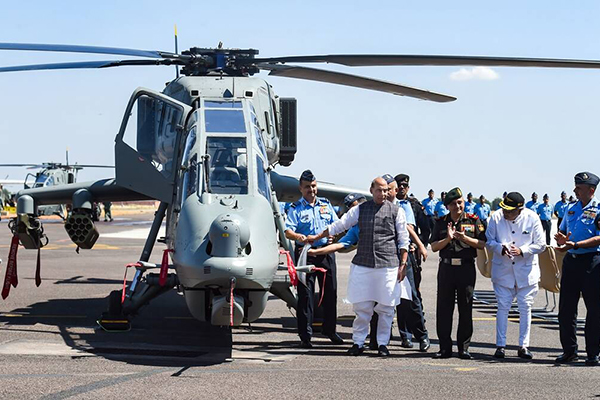
The indigenous Light Combat Helicopter (LCH), capable of destroying enemy air defence, conducting counter insurgency strikes and much more, was formally inducted into the Indian Air Force (IAF) at the Jodhpur air base on 3 October. The fleet of four helicopters was inducted at a ceremony in presence of Defence Minister Rajnath Singh, Chief of Air Staff Air Chief Marshal VR Chaudhari and other senior military officials. The helicopter will be called ‘Prachand’, which means fierce.
According to its makers, the LCH is the only attack helicopter in the world which can land and take off at an altitude of 5,000 meters with a considerable load of weapons and fuel, meeting the specific requirements laid out by the Indian Armed Forces.
Here is the story of its development by state-owned Hindustan Aeronautics Ltd (HAL), its unique features, its importance as a strategic asset and the road it faces ahead.
Genesis of the Light Combat Helicopter
It was during the 1999 Kargil war that the need was first felt for a homegrown lightweight assault helicopter that could hold precision strikes in all Indian battlefield scenarios. This meant a craft that could operate in very hot deserts and also in very cold high altitudes, in counter-insurgency scenarios to full-scale battle conditions.
India has been operating sub 3 ton category French-origin legacy helicopters, Chetak and Cheetah, made in India by the HAL. These single engine machines were, primarily, utility helicopters. Indian forces also operate the Lancer, an armed version of Cheetah. In addition, the Indian Air Force currently operates the Russian origin Mi-17 and its variants Mi-17 IV and Mi-17 V5, with maximum take off weight of 13 tonnes, which are to be phased out starting 2028.
But the requirement was for a more agile, multi-role dedicated attack helicopter. After the initial deliberations, the government sanctioned the LCH project in October 2006, and HAL was tasked to develop it. The HAL’s Rotary Wing Research and Development Centre, which had already worked on the Advanced Light Helicopter (ALH) Dhruva and its weaponised version ALH Rudra, embarked upon the project.
The development of Light Combat Helicopter
The LCH has been designed as a twin-engine, dedicated combat helicopter of 5.8-ton class, thus categorised as light. It features a narrow fuselage and tandem — one behind the other — configuration for pilot and co-pilot. The copilot is also the Weapon Systems Operator (WSO). While LCH inherits many features of the ALH, it mainly differs in tandem cockpit configuration, making it sleeker. It also has many more state-of-art systems that make it a dedicated attack helicopter.
In the LCH’s journey towards clearance and induction by the IAF and the Army, extensive flight testing has been carried out on four prototypes, also known as Technology Demonstrators (TDs).
The first Technology Demonstrator was completed in February 2010 and took its first flight on March 29 the same year. TD-2 prototype, completed around 2012, successfully passed the cold weather trials at high altitude. TD-3 and TD-4 prototypes, completed around 2014 and 2015, successfully tested other flight test requirements.
HAL officials said that the flight testing was carried out at various altitudes, from sea level to the Siachen range, in extreme cold and hot weather conditions, and in desert regions. During these tests, integration of mission sensors such as electro-optical system, helmet-mounted display system, solid state data and video recorder, and weapon systems such as turret gun, rockets and air-to-air missile systems was carried out. Weapon firing trials were also completed. The four prototypes have together undergone over 2,000 flights with close to 1600 flight hours.
Initial operational clearance came in 2017 for the IAF variant and in 2019 for the Army variant. In August 2020, the MoD added LCH to the items under import embargo. In November 2021, Prime Minister Narendra Modi symbolically handed over the LCH to the Indian Air Force, paving the way for its final induction.
In March this year, the Cabinet Committee on Security (CCS) approved procurement of 15 LCH Limited Series Production (LSP) — 10 for IAF and five for Army — at the cost of Rs 3,887 crore along with infrastructure sanctions worth Rs 377 crore.
Features, significance of the Light Combat Helicopter
LCH has the maximum take-off weight of 5.8 tonnes, maximum speed of 268 kilometers per hour, range of 550 kilometers, endurance of over three hours and service ceiling — the maximum density altitude to which it can fly — of 6.5 kilometres.
The helicopter uses radar-absorbing material to lower radar signature and has a significantly crash-proof structure and landing gear. A pressurised cabin offers protection from nuclear, biological and chemical (NBC) contingencies.
The helicopter is equipped with a countermeasure dispensing system that protects it from enemy radars or infrared seekers of the enemy missiles. As far as weapons systems are concerned, a 20 mm turret gun, 70 mm rockets and air-to-air missile systems are onboard.
LCH is powered by two French-origin Shakti engines manufactured by the HAL.
With these features, the LCH has the capabilities of combat roles such as destruction of enemy air defence, counter insurgency warfare, combat search and rescue, anti-tank, and counter surface force operations.
The road ahead
According to HAL there is a projected requirement of 160 LCHs — 65 for IAF and 95 for Indian Army. After receiving a contract for the LSP in March, some units have already been delivered and the rest are at various stages of acceptance. HAL has said that it has drawn a detailed masterplan for achieving the peak rate production capacity of 30 helicopters per year in order to produce the remaining 145 LCHs in eight years from the date of signing of Series Production order.
For export, the HAL has already obtained a no objection certificate from the Ministry of Defence for countries like Malaysia, Thailand, Vietnam, Angola, Egypt, Indonesia, Ecuador and Nigeria, sources have said.

















